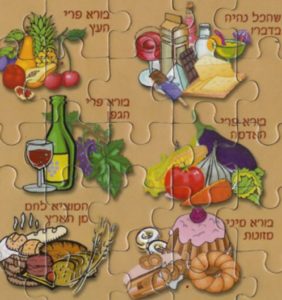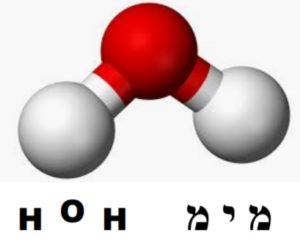This week’s parasha, Ekev, begins by stating that if the Jewish people observe God’s laws, He will in turn bless us tremendously. The first aliyah ends with the famous verse “And you will eat and be satiated and bless God…” The Zohar (Ra’aya Mehemna) begins its commentary on the parasha by explaining the meaning of a berakhah, “blessing”. It explains that when we recite a blessing, beginning with the words Barukh atah Adonai, it does not mean that we are blessing God, rather that God is the source of all blessing. We derive our blessings from Him.
The next words Eloheinu melekh haolam secretly allude to the fact that, when we recite blessings, we help to restore balance to the universe. The Tetragrammaton (referred to as “Adonai”) is the name of God associated with kindness and mercy, while Elohim is the name associated with judgement and severity. These are the two opposing forces upon which the universe is built. God is the melekh, “king”, who carefully weighs these two attributes. Blessings, too, have the power to maintain the balance between kindness and severity, keeping the olam, “universe”, going. This is the deeper meaning behind the formula of words with which we begin our blessings.
 In Sha’ar HaMitzvot on this week’s parasha, the Arizal builds on the Zohar with his own lengthy exposition on blessings, primarily those recited before and after eating. As is well-known, there are six types of blessings recited on foods before consumption, and three blessings afterwards. Hamotzi lechem min ha’aretz is the conclusion for the blessing recited on bread, and bor’e minei mezonot on other goods made from the five grains (wheat, barley, spelt, rye, oat) as well as on rice. Bor’e pri hagefen is recited on wine; bor’e pri ha’etz on produce that comes from trees (more specifically, perennials that grow at least a foot above the ground); and bor’e pri ha’adamah on produce from the ground. Finally, the most generic blessing—on everything else—is shehakol nihyah bidvaro, that “everything came to be according to His word”.
In Sha’ar HaMitzvot on this week’s parasha, the Arizal builds on the Zohar with his own lengthy exposition on blessings, primarily those recited before and after eating. As is well-known, there are six types of blessings recited on foods before consumption, and three blessings afterwards. Hamotzi lechem min ha’aretz is the conclusion for the blessing recited on bread, and bor’e minei mezonot on other goods made from the five grains (wheat, barley, spelt, rye, oat) as well as on rice. Bor’e pri hagefen is recited on wine; bor’e pri ha’etz on produce that comes from trees (more specifically, perennials that grow at least a foot above the ground); and bor’e pri ha’adamah on produce from the ground. Finally, the most generic blessing—on everything else—is shehakol nihyah bidvaro, that “everything came to be according to His word”.
After finishing a meal, there are three possible blessings to recite. A full meal that begins with bread concludes with the lengthy birkat hamazon and its four blessings. Following mezonot (but not rice), wine, or one of the five fruits of Israel (pomegranates, grapes, olives, figs, dates) one recites the blessing known as m’ein shalosh. After consuming anything else, one recites bor’e nefashot. The earliest source to discuss the latter blessing is the Mishnah, Berakhot 6:8: “One who drinks water to quench his thirst recites shehakol nihyah bidvaro. Rabbi Tarfon says: bor’e nefashot rabbot.” The Sages dispute which blessing one recites before drinking water. The Talmud (Berakhot 45a) settles the debate by saying: “Go out and see what the people are doing!” In other words, by that point in time the proper halakhah had long been established and everyone knew that we recite shehakol before and nefashot after.
While the Sages are technically discussing the case of water, this halakhah applies to all shehakol foods. Why is it that these berakhot—originally discussed specifically with regards to water—became the standard blessings for all foods? And what is the meaning behind their perplexing words?
Source of Life
The Arizal (ibid.) explains that, of course, all living things are entirely dependent on water. Not surprisingly, when scientists look for signs of life on other planets, the first thing they look for is water. Water is life! In fact, the Sages sometimes refer to water as chai, “life” (see, for instance, Berakhot 51a). This is wonderfully alluded to in the molecular nature of water, whose molar mass is 18 g/mol, 18 being the gematria of chai (חי).

“A water molecule has just three atoms bonded to each other. It is interesting to note how this molecule’s shape (two hydrogens flanking an oxygen in a “bent” structural
conformation) mirrors… the Hebrew word for water, מים) two mems flanking a yud).” (From Secrets of the Last Waters)
[A quick high school chemistry review: a hydrogen atom has 1 proton and weighs 1 atomic mass unit, while an oxygen atom has 8 protons and 8 neutrons, weighting 16 atomic mass units. Since water has two hydrogens and one oxygen—H2O—it has a combined mass of 18 atomic mass units, or 18 grams per mole (g/mol), meaning a mole (6.02 × 1023) of water molecules will have a mass of 18 grams.]
This will help us explain the shehakol and nefashot blessings on a deeper level. Water is the source of all life, and almost everything we eat comes from a living thing which is made mostly of water, too. When you eat a food, you are really eating a large mass of water. An apple, for example, is actually 84% water, while a chunk of beef is 73% water (the rest being protein, fat, and everything else).
When we say shehakol nihyah bidvaro, that “everything came to be according to His word”, we are meant to think back to Creation when everything first came into existence. What makes up everything in existence anyway? Both Torah and science agree that all matter comes down to light and energy. The atoms that make up all matter condensed from an initial burst of radiant energy. Yet, the atom itself is over 99.9% empty space! It’s a bit of condensed energy and a lot of nothing. Combine hydrogen and oxygen atoms and you get water molecules, which make up almost all of life. Plants, animals, bacteria, people—we are bunches of water molecules plus a handful of other mostly-empty-space elements (carbon, iron, phosphorus).
We might therefore conclude that the basic ingredients for life are just some energy, lots of space, and water. Amazingly, the ancient Jewish mystics said the exact same thing (see Sha’ar Ruach HaKodesh, drush 2). They explained that when the Torah says God spoke (אמר) everything into existence (“God said, ‘Let there be…’”), he had three basic ingredients: light (or energy), water, and space; in Hebrew: or (אור), mayim (מים), rakia (רקיע). The initials of these words spell amar (אמר), as in vayomer Elohim yehi, “And God said, ‘Let there be…’”. This is the secret meaning of God “speaking” everything into existence. We say shehakol nihyah bidvaro to remind us of this deep mystery.
It is important to note that, halakhically, the shehakol and nefashot blessings apply to all foods, and even if one recites them on bread or wine or something that has its own unique blessing, they have fulfilled the mitzvah nonetheless. This does not work in reverse! Only the water blessings incorporate all other blessings. The Arizal points out that the shehakol blessing has a total of nine words, corresponding to the nine yuds within the four mystical permutations of God’s Ineffable Name. Each yud has a numerical value of ten, so altogether they sum up to 90, which is the gematria of mayim, “water” (מים). One should, the Arizal taught, meditate upon this whenever reciting shehakol. (It is the yud in particular that matters because the yud is the letter that symbolizes Creation, as the Zohar says that Creation began with a nikkudah hada d’zohar, “a singular point of radiance”, symbolized by the point-like letter yud.)
Souls Out of Water
After we conclude eating, we recite the nefashot blessing, loosely translated: “…who creates many souls and their needs, for all that You have created to sustain through it the soul of every living thing. Blessed is He who is the life of all worlds.” The translation makes little sense on the surface, but neither does the original Hebrew!
The Arizal explains that, again, it all comes down to water. The term v’chesronan, the “needs” of all living things, is alluding to water since all living things need water. (Interestingly enough, from a scientific perspective, not all living things need food, and some don’t even need oxygen, but every living thing needs water!) The Arizal points out what we have already discussed, that food is mostly water anyway. Yet, the most critical message of this berakhah is to remember that life cannot be explained simply with chemicals. The text of the blessing tells us that God created all living things (bor’e nefashot rabbot), and all of the resources they need to survive (v’chesronan)—chief among them, water—but ultimately it is God who sustains the living, and God is chai haolamim, the “life of all worlds”.

Because of their bent shape and a strong intermolecular force called hydrogen-bonding, water molecules tend to crystallize into hexagram shapes reminiscent of a Star of David.
That olamim, “worlds”, is plural is no accident. God, of course, sustains all living things in all worlds: this lower world which we inhabit, and all the higher worlds above. And water happens to be the key to life everywhere, too, in all worlds. While it may appear that water is simply a physical, chemical substance, it is far more than that. Aside from its strange behaviour (such as how it expands when freezing instead of contracting, not to mention its highly controversial, perhaps pseudo-scientific ability to respond to speech and “absorb” information), water has incredible spiritual power.
The Torah tells us that at the very beginning, “the spirit of God hovered upon the face of the water” (Genesis 1:2). Before the physical world was created, water already existed. We read that God “established His upper chambers in water” (Psalms 104:3). There is water in the spiritual realms as well! After all, it is called shamayim, literally sham-mayim, “water-there”. This is one reason why, when Rabbi Akiva and his three colleagues famously ascended to the Heavens (Chagigah 14b), Rabbi Akiva warned them about seeing water in the worlds beyond. (For a deeper analysis of these mysteries, see Secrets of the Last Waters.) Incredibly, the Arizal says that even souls initially emerge from water. This, too, is alluded to in the words of the blessing, bor’e nefashot rabbot, that God creates many souls—out of the Heavenly waters.
Down here below, where everything is a reflection of what goes on Above, a soul similarly emerges into the world by “breaking the waters” of the womb. Just as a child’s physical body forms suspended in a bubble of water in its mother’s womb, so too does its soul form in the waters of God’s Heavenly “womb”. Perhaps this is why God tells us that He has compassion upon us “like a father upon his children”, k’rachem av ‘al banim, where the word rachem (רחם) is the exact same as the word for a “womb”, rechem.
Something to think about next time you pick up a glass of water.
Happy Tu b’Av!
From the Archives: ‘Why Tu b’Av is More Important than Yom Kippur’

Pingback: Mysteries of Fire | Mayim Achronim